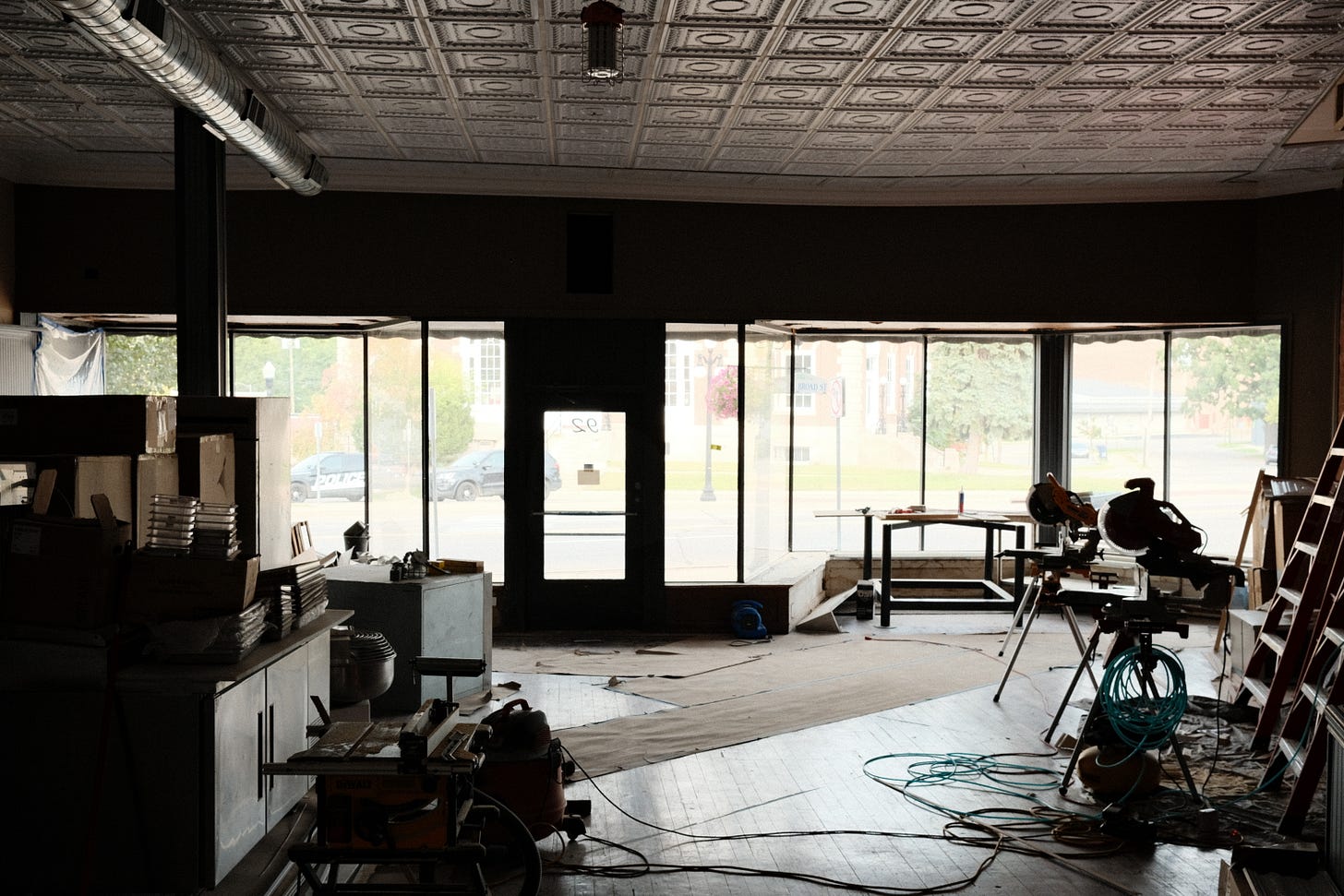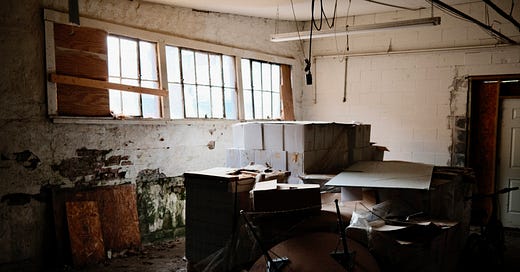
Dear Boss,
Hillsdale finds itself in a time of renewal. Ultimately, this renewal will spark economic, intellectual, and relational growth in the City of Hillsdale, but first, the City must be given a boost in the right direction. One of the first issues facing the City is poor planning, made in previous decades, that has severely handicapped the growth of the City and made the City uglier in the process. These changes were imposed out of a wrong-minded understanding of the nature of cities and local economic growth. This wrong understanding was turbocharged by easy access to state and federal funding. For Hillsdale to thrive, we must first work to reverse these changes and set Hillsdale back on track to flourishing.
Jane Jacobs (1916-2006) was a leading 20th-century critic of then-modern “scientific” city planning. The bulk of her criticism was leveled at the federal policy known as the “Urban Renewal Act.” Urban Renewal gave cities vast federal funds to demolish and rebuild city structures and realign cities according to top-down “expert” designs. Under Urban Renewal, “experts” destroyed small businesses, churches, and homes. These bastions of community were replaced with supposedly efficient, high-throughput roads and income-restricted housing developments.

What began in naive optimism ended in brutish disaster. Natural communities were demolished, never to be relocated, and income restrictions on project housing doomed residents into remaining social outcasts. Urban Renewal was a horrible assault on local wealth creation and growth.
An example of this approach can be found locally in Hillsdale. Midway through the 1900s, the State of Michigan, in partnership with the City of Hillsdale, placed a state highway that runs right through the heart of Downtown. The city planners assumed this would bring more money into town as traffic flows increased. In reality, the highway placement neutered Downtown growth and brought extra traffic that only seeks to drive through Hillsdale rather than stopping and benefitting local businesses. Not only does this traffic not stop in Hillsdale, it also increases wear and tear on our local roads and terrorizes local pedestrians. Further, its establishment required old trees to be cut down and old buildings to be destroyed. A formerly venerable neighborhood was irreparably tarnished by the sound of heavy trucks rolling through town.
According to Jacobs, Urban Renewal and similar policies occurred because of a misunderstanding regarding the nature of cities. City planners viewed cities as machines rather than organisms, and acted accordingly. If there’s a problem with a machine, you need to swap one part out in favor of another, and the device will run smoothly. If there’s a problem with an organism, taking out its liver and replacing it with a spleen will result in death. Proper care requires genuine love of the place and a gentle touch.
In the case of Hillsdale, a quiet downtown street was replaced with a busy highway. The planners assumed, rightly, that this would increase traffic flows. However, they did not consider the nature of the traffic that travels on that type of road, the effects the traffic would have on pedestrians, or the costs it would impose on the local community. The planners did not stop to wonder why the people of Hillsdale had not themselves sought to create a highway-class road running through their small town. In the end, what was naturally born was unnaturally demolished. Following Jacobs, cities are to be viewed as living, breathing creatures of human will and enterprise rather than Frankensteins, born in pseudo-scientific planning and birthed by bureaucratic execution. Cities cannot be defined or remedied in mechanical terms, and pursuing fixes in that manner will frustrate our ability to create a thriving town.
Taking a significant stake in Downtown Hillsdale and working to restore Downtown’s beauty will allow me to pursue the work of reversing the effects of poor ideas and policy. Modern civic life requires the participation of the government as well as private entrepreneurs. I can throw all the money in the world at restoring buildings to their former glory, but I need the help of politicians and bureaucrats to widen sidewalks, plant trees, create bump-outs at intersections, and put wide roads on a diet. These changes, which require political remedies, will allow Downtown Hillsdale to become a walkable and enjoyable place to gather and do business.
As anyone with a fourth-grade knowledge of biology understands, life comes into being through partnership. In the biology of cities, these partnerships form in pursuit of shared economic, intellectual, or political goals. These goals are accomplished by neighbors forming groups dedicated to pursuing a shared good life. If those partnerships fail to develop in a city, the first thing to do is fix the requirements for those partnerships. In the city, this first requires basic civic order. It then requires spaces in which partnerships can form and bear fruit. At this second level, Hillsdale Renaissance begins by restoring Downtown Hillsdale’s architecture and infrastructure.
Downtowns are essential for the life of a city because they offer a bevy of buildings close to one another and short, walkable distances between businesses and apartments. The Downtown allows life to bubble up naturally, in the middle of things, as people walk, talk, and gather in approachable shared spaces. Furthermore, Downtowns are generally more beautiful than most other spaces in a city. This is mainly because most Downtowns were built before the government imposed heavy regulations on the building process, drastically increasing the cost of building (in the past, building expenses were lavished on small, beautiful touches and sturdy building materials; today, building expenses are poured out onto wearisome regulations and permits). This crafted beauty ennobles the human spirit by reminding us that we, too, can pursue and engender beauty.
Restoring Downtown architecture and infrastructure is the first step in Hillsdale Renaissance’s project. I currently own 15 buildings in Hillsdale. If I were to do nothing (not employ anyone, not renovate any buildings, and merely collect rent), those buildings would produce ~$40,000 in annual profit for me. By any measure, that is an abysmal rate of return.

Luckily, that problem can be alleviated. Commercial and residential rents are extraordinarily low in Downtown Hillsdale and will need to gradually increase over time, but the main problem is the spaces that are uninhabitable due to their poor condition. Over 50% of my purchased space is vacant due to poor maintenance or neglect. If people want to live and work in Hillsdale, they must have suitable space to live and work. I need to moderately raise rents, but I primarily need to restore these uninhabitable spaces. Their restoration will overwhelmingly benefit the economic prospects of everyone who lives and works Downtown, making the moderate rent increases palatable. Making these properties inhabitable will also make the project financially viable, allowing the rent roll to increase exponentially. The responsible management of this rejuvenation will enable sustainable investment into the Downtown for decades to come.
The physical restoration of Downtown will lay the groundwork for a true renaissance in Hillsdale. At a base level, the restoration will allow for continued maintenance and improvement of the Downtown infrastructure. It will also encourage future growth as locals and outsiders see Hillsdale as a town on the rise. Finally, it will allow me to pursue the ultimate goal of encouraging Hillsdale to become a place where Americans nationwide can gather, learn, create, and debate how best to live. My next update will dive into the resources unique to the City of Hillsdale, discuss how to leverage those resources, and imagine what a shared life in that renewed City might look like.




I am really enjoying your writing and following your project closely, Luke. Good work!
Awesome! It took me so long to realize that ugliness in many midwest small cities was not (at least merely) a necessary result of modernity, but actually the direct effect of a flawed philosophy regarding architecture and urban design specifically. Jacobs is like the Alasdair Macintrye of UD. Get the anthropology right!